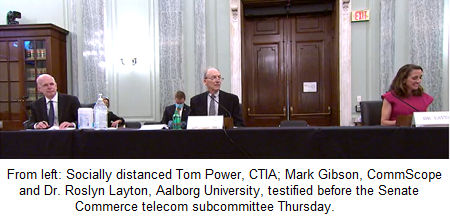Wireless spectrum took center stage in multiple venues yesterday. The Senate Commerce telecom subcommittee heard from witnesses, including CTIA and CommScope, about how the FCC and administration have managed spectrum allocation in the wake of several high-profile 5G disputes. The hearing occurred as the Citizens Broadband Radio Service (CBRS) auction began (see story below.)
If wireless companies don’t have enough spectrum, rural areas will fall behind in getting 5G, subcommittee chair John Thune (R-SD) said. He called for the federal government to focus on using its own spectrum holdings more efficiently and to better use the Spectrum Relocation Fund, a federal source of money that helps cover the cost of agencies moving to new spectrum bands. “We need to make sure the interagency process when making these decisions is transparent,” the GOP whip said.
CTIA General Counsel Tom Power warned of global implications surrounding limited availability of prime mid-band spectrum. Other countries are ahead of the U.S. on allocating prime 5G mid-band spectrum, he said, noting that by year-end, “China will be five times ahead of us.” He cautioned the spectrum pipeline is running dry and recommended the lower 3 MHz band, currently held by the Pentagon, as the next best target.
CommScope Director of Business Development Mark Gibson testified that the CBRS spectrum auction is the culmination of eight years of collaboration between industry, government and others. “However, eight years to commercialize a band like CBRS is simply too long.”
“We need to shorten the spectrum availability pipeline,” Gibson said. “CommScope supports a comprehensive long-term spectrum policy [that] should include newer dynamic sharing regimes.”
Michael Calabrese, Director of the Wireless Future Project at the Open Technology Institute at New America, called the turf wars between the FCC and the rest of the federal government “discouraging.”
Thune noted that the National Telecommunications Information Administration (NTIA) “is supposed to speak for the entire executive branch. But some agencies communicate with the FCC rather than NTIA, according to Thune. He asked whether the interagency spectrum process worked as intended.
Power said more collaboration among the federal government agencies is needed and recent changes at the top of NTIA “hasn’t helped.” He suggested there needs to be a “commitment to get all the engineers in a room” in a “continued, sustained collaborative effort,” to work out spectrum allocations.
Gibson said there’s more shared spectrum use now and the agreement between the FCC and NTIA is now 17 years old. He suggested there needs to be a process to handle escalating disputes during an FCC proceeding, rather than after the agency has reached a tentative conclusion.
Dr. Roslyn Layton, Visiting Researcher from Aalborg University, agreed, saying, “We’re dancing around federal [spectrum] holdings. We need to take the bull by the horns.” She said the committee can do more. Disagreements about spectrum use are not new, she pointed out, citing that during WWII, broadcasters needed to use spectrum the military wanted.
“We have to figure this out. The stakes are high and our competitors are not waiting. The costs of not being competitive in 5G will cost our country in many ways,” Thune concluded.
By Leslie Stimson, Inside Towers Washington Bureau Chief





Reader Interactions